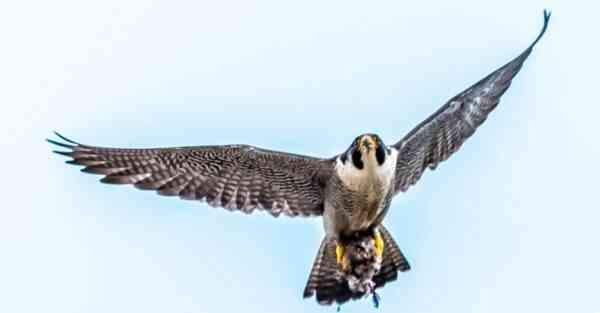Swift and merciless aerial predators, falcons are able to reach speeds comparable to the speed of a racing car when diving for prey. Smart and quick-witted, these birds have been used by hunters since ancient times, and falconry — a separate art form.
Interesting facts about falcons
- Specialists have given the falcon a scientific name that has become a derivative of the Latin word for sickle. So scientists emphasized the shape of the wings of these birds, which during the flight resembles a sickle (interesting facts about birds).
- Falcons are the central and largest genus of the falcon family. In total, this family includes 11 genera and about six dozen species of birds.
- Pygmy falcons are the smallest raptors on the planet. The size of their bodies is only 15-19 cm.
Peregrine falcons are considered the fastest among all animals inhabiting the Earth. During a dive, these birds can accelerate up to 322 km/h, or 90 m/s, while peregrine falcons lose to swifts in horizontal flight speed. - Falcons gave their name to a special kind of hunting using birds of prey. People engaged in such hunting are called falconers.
- At the beginning of the 21st century, one of the Canadian scientists proposed to determine the level of intelligence of birds based on the ingenuity they show during hunting. According to this technique, falcons are among the smartest birds on the planet.
- Falcons live all over the globe, except for Antarctica (interesting facts about Antarctica).
- Falcons build their own nests on the ground, rock ledges or tall buildings, but do not disdain to capture the dwellings of other birds in trees.
- Falcons are a relatively young family compared to other birds of prey. Findings made by scientists suggest that they appeared on the planet less than 10 million years ago, during the late Miocene.
- Studies have shown that the homeland of kestrels and merlins is the African continent, and all other falcons settled around the world from Eurasia.
- Due to the swiftness of their flight, falcons hunt large birds, attacking them in the air. Mammals also sometimes become their prey.
- Small merlin falcons build nests in the mountains at an altitude of up to 2000 m, and during the migration period they rise to 3000 m.
- The evening falcon got its name for predilection for hunting at dusk. Bats form the basis of the diet of these birds.
- The New Zealand falcon is featured on the local $20 bill.
- The global population of saker falcons has declined by 47% over the past 20 years.
- Some scientists believe that the turula , the messenger of the gods from Hungarian mythology, the Altai falcon.
- Gyrfalcon is the largest species of falcons. Female gyrfalcons weigh up to 2 kg, males – half as much. Their wingspan is about 120-135 cm with a body size of up to 60 cm.
- Peregrine falcons fall on their prey from a great height and almost perpendicular to the ground – the blow of the paws of this bird has such destructive power that even relatively large animals, the head can separate from the body.
